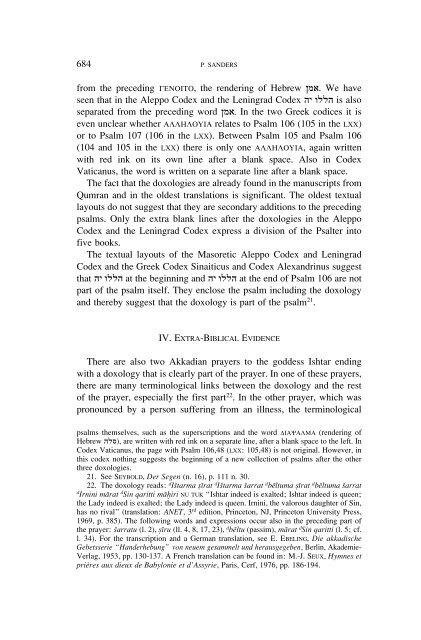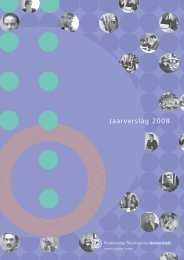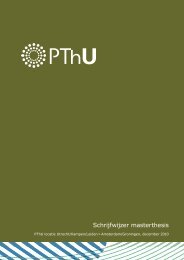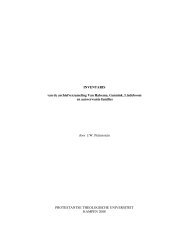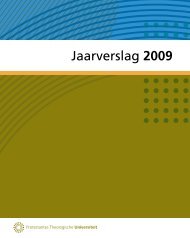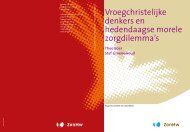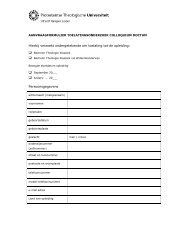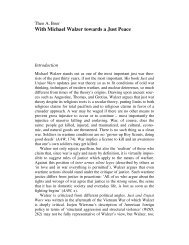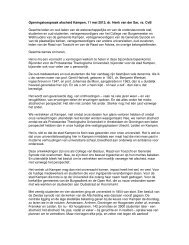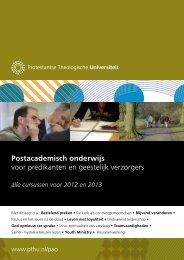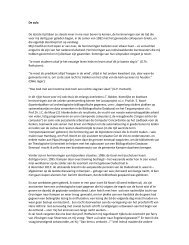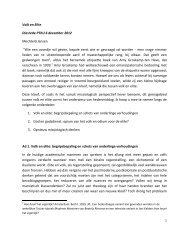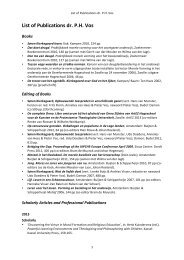the composition of the book of psalms - Protestantse Theologische ...
the composition of the book of psalms - Protestantse Theologische ...
the composition of the book of psalms - Protestantse Theologische ...
You also want an ePaper? Increase the reach of your titles
YUMPU automatically turns print PDFs into web optimized ePapers that Google loves.
684 P. SANDERSfrom <strong>the</strong> preceding GENOITO, <strong>the</strong> rendering <strong>of</strong> Hebrew .אמן We haveseen that in <strong>the</strong> Aleppo Codex and <strong>the</strong> Leningrad Codex הללו יה is alsoseparated from <strong>the</strong> preceding word .אמן In <strong>the</strong> two Greek codices it iseven unclear whe<strong>the</strong>r ALLJLOUIA relates to Psalm 106 (105 in <strong>the</strong> LXX)or to Psalm 107 (106 in <strong>the</strong> LXX). Between Psalm 105 and Psalm 106(104 and 105 in <strong>the</strong> LXX) <strong>the</strong>re is only one ALLJLOUIA, again writtenwith red ink on its own line after a blank space. Also in CodexVaticanus, <strong>the</strong> word is written on a separate line after a blank space.The fact that <strong>the</strong> doxologies are already found in <strong>the</strong> manuscripts fromQumran and in <strong>the</strong> oldest translations is significant. The oldest textuallayouts do not suggest that <strong>the</strong>y are secondary additions to <strong>the</strong> preceding<strong>psalms</strong>. Only <strong>the</strong> extra blank lines after <strong>the</strong> doxologies in <strong>the</strong> AleppoCodex and <strong>the</strong> Leningrad Codex express a division <strong>of</strong> <strong>the</strong> Psalter int<strong>of</strong>ive <strong>book</strong>s.The textual layouts <strong>of</strong> <strong>the</strong> Masoretic Aleppo Codex and LeningradCodex and <strong>the</strong> Greek Codex Sinaiticus and Codex Alexandrinus suggestthat הללו יה at <strong>the</strong> beginning and הללו יה at <strong>the</strong> end <strong>of</strong> Psalm 106 are notpart <strong>of</strong> <strong>the</strong> psalm itself. They enclose <strong>the</strong> psalm including <strong>the</strong> doxologyand <strong>the</strong>reby suggest that <strong>the</strong> doxology is part <strong>of</strong> <strong>the</strong> psalm 21 .IV. EXTRA-BIBLICAL EVIDENCEThere are also two Akkadian prayers to <strong>the</strong> goddess Ishtar endingwith a doxology that is clearly part <strong>of</strong> <strong>the</strong> prayer. In one <strong>of</strong> <strong>the</strong>se prayers,<strong>the</strong>re are many terminological links between <strong>the</strong> doxology and <strong>the</strong> rest<strong>of</strong> <strong>the</strong> prayer, especially <strong>the</strong> first part 22 . In <strong>the</strong> o<strong>the</strong>r prayer, which waspronounced by a person suffering from an illness, <strong>the</strong> terminological<strong>psalms</strong> <strong>the</strong>mselves, such as <strong>the</strong> superscriptions and <strong>the</strong> word DIACALMA (rendering <strong>of</strong>Hebrew ,(סלה are written with red ink on a separate line, after a blank space to <strong>the</strong> left. InCodex Vaticanus, <strong>the</strong> page with Psalm 106,48 (LXX: 105,48) is not original. However, inthis codex nothing suggests <strong>the</strong> beginning <strong>of</strong> a new collection <strong>of</strong> <strong>psalms</strong> after <strong>the</strong> o<strong>the</strong>rthree doxologies.21. See SEYBOLD, Der Segen (n. 16), p. 111 n. 30.22. The doxology reads: d Istarma Òirat d Istarma sarrat d beltuma Òirat d beltuma sarratdIrnini marat d Sin qaritti maÌiri NU TUK “Ishtar indeed is exalted; Ishtar indeed is queen;<strong>the</strong> Lady indeed is exalted; <strong>the</strong> Lady indeed is queen. Irnini, <strong>the</strong> valorous daughter <strong>of</strong> Sin,has no rival” (translation: ANET, 3 rd edition, Princeton, NJ, Princeton University Press,1969, p. 385). The following words and expressions occur also in <strong>the</strong> preceding part <strong>of</strong><strong>the</strong> prayer: sarratu (l. 2), Òiru (ll. 4, 8, 17, 23), d beltu (passim), marat d Sin qaritti (l. 5; cf.l. 34). For <strong>the</strong> transcription and a German translation, see E. EBELING, Die akkadischeGebetsserie “Handerhebung” von neuem gesammelt und herausgegeben, Berlin, Akademie-Verlag, 1953, pp. 130-137. A French translation can be found in: M.-J. SEUX, Hymnes etprières aux dieux de Babylonie et d’Assyrie, Paris, Cerf, 1976, pp. 186-194.


